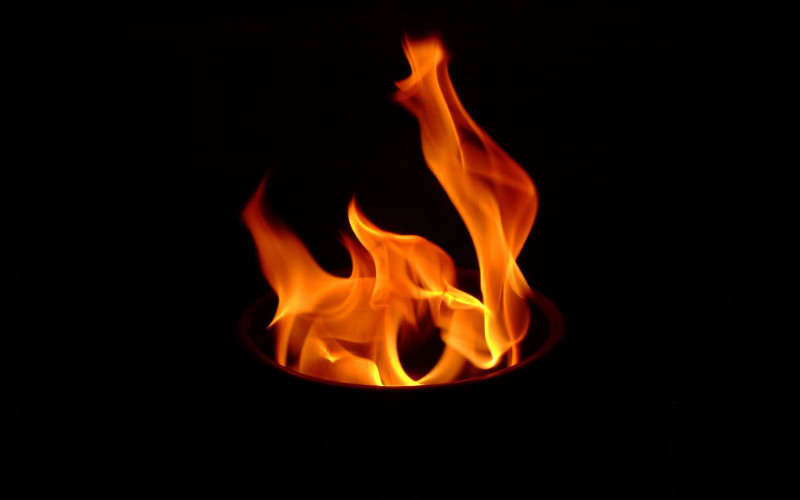Hell’s Heresiarch
Chris Quinn
“I am locked out of Heaven. But even if it were laid bare before me, and all the angels sung my praises, and God the Lord Jesus kissed my forehead and bade me enter that place, I would deny Him three times and three times again and yet again and again. For I will not walk through the gates of Heaven until the world walks through first.”
—An alleged passage of the Gospel of Glarayn
It is both a technical and creative process to capture the social dynamics of Hell.[1] Field study is difficult: there is little to no social interaction. Inhabitants are often reticent and reclusive, many being deeply involved in completing some task in relative solitude.[2] Of those who are socially participatory, they tend to be cryptic in their communications. A kind of unspoken dread hangs over all damned souls, and open communication is clearly hindered by it. Analysis is difficult: I myself am obviously damned, and therefore the fervor and quality of my research and reporting are of little importance to me. The same inhibitions of open communication that others suffer, I suffer from also. And lastly, and perhaps most pragmatically, there is a lack of writing implements in Hell: I often find myself writing upon tanned and dried flesh with melted bone marrow that I allow to drip from a pin hole in the metacarpals that I pull from assorted body parts. However, despite these challenges, this specific investigation piqued my interest somewhat more than others, as it pertains to a world beyond the world we damned have left. It raises questions that I, as a Damnologist, find overwhelmingly difficult to answer, seeing as it appears that this enigmatic group of people, who I have named the Glarynites, appear to have created a worldview that was born, and continues to exist, within the depressing and confining restrictions of Hell. Yet this worldview points to a life beyond Earth—and beyond even Heaven and Hell.
I know only one Glarynite thus far:[3] I first met the soul of Nat, as he called himself, during a general observation of the damned souls of Hell. I was reticent and unsure of my next topic of study, and I hoped a general inquiry of the day to day lives of damned souls would raise a question in me that would be worthy of research and thought. I approached a damned soul who seemed to me more invested in his actions than most. Nat was dissecting a newly arrived corpse, a mirroring of the way he spent his life on earth as a surgeon, presumably due to the enforcement of the Pre-Revelation Damnation Code.[4] Nat, a professed agnostic during his lifetime, told me that he was “not exactly sure why he was condemned to Hell,” but it may have to do with his “role in secular celebrations, specifically due to a propensity for the consumption of alcohol and gluttonous amounts of food during those celebrations, most notably during Thanksgiving and Christmas. Or perhaps it was an interest in dendrology, which I had since young adulthood, and which oddly colored my spiritual life.” He died of old age in his eighty-fifth year, following sixty years of happy marriage and nearly as much in a happy career, saving numerous lives and being a productive and happy member of his community and, in retirement, an enthusiastic volunteer, and later member of the board, for the International Arbor Society. In these positions, he traveled the world studying and planting trees in North America, Asia, and the Middle East.
Nat had been in Hell for only thirty-five years, if his estimate is to be believed, and I don’t care to corroborate his claims because it requires a sensational amount of time, energy, and dealings with the Records Department.[5] So I simply take him at his word as his history has no foreseeable effect on the ideas which he introduced to me. Both of us being academics and men of science upon earth, I counted upon him to convey to me his ideas in a trustworthy and straight forward manner. I have no reason to believe he did otherwise.
Nat conveyed to me a belief in an angel[6] whom he called Glarayn Glarayn. According to Nat, Glarayn Glarayn was a fallen angel, one of whom descended into Hell alongside Lucifer following the Angelic War with God. Glarayn Glarayn readily accepted banishment from Heaven, and immediately sought to design and construct a new divine realm alongside his ally Lucifer. Glarayn Glarayn’s underworld would be the antithesis of God’s Heaven: instead of oblivious and blissful contentment only for those who knew the name of the Lord, Hell would demand rigorous awareness of personal responsibility through a focus on past deeds regardless of the acceptance of Jesus as Christ. The goal being that through intense self-examination, the damned soul would release itself from its past wrongdoings, being granted forgiveness through the Holy Spirit of God[7], and ascend not to Heaven, but to a complete and unifying state of cosmic understanding, which Glarayn Glarayn believes to be the true Heaven described by Jesus the Christ.[8]
Glarayn Glarayn, even during his time in Heaven before the Angelic War, held this vision of a new divine order in his mind. He attempted, though without success, to influence the order of Heaven which God had imposed. So when Lucifer first spoke those fateful words, “I will not serve,” to God, Glarayn Glarayn immediately supported the uprising. He saw Lucifer’s rebellion as a step in the direction of responsibility for each individual in a world of free will, with the punishments and rewards to fit the choices made in such freedom, yet with a road to redemption for those who failed to see unity upon the Earth during their lifetime. He left behind the law of God in Heaven, and sought to create his own in Hell. Unfortunately, Glarayn Glarayn was unable to influence Lucifer in his designs of the new Underworld. Shirking any advice from Glarayn Glarayn, Lucifer created the Hell of the Ancients, in which Seven Circles of increasing punishment held tortures in ascending severity. This Hell of the Ancients focused solely on the administration of mind blurring pneumatic punishments, specifically through the use of fire, and as such, Glarayn Glarayn despised the Hell of the Ancients.[9] He rebelled against Lucifer, tearing asunder the seven circles in the ensuing war. Glarayn Glarayn’s rebellion forced Lucifer to flee to Heaven to beseech God for help in protecting the divinely ordained separation of Heaven and Hell, of Right and Wrong, of Light and Dark—in short, that which Glarayn Glarayn sought to destroy—and it struck fear into the hearts of both God and Devil. So God sent seven archangels into the ruins of Hell, and they slew Glarayn Glarayn, each archangel wielding a divinely blessed sword of Divine Justice. Glarayn Glarayn’s body was cast into a boiling pool in the River Lethe, and it is said that the corpse of Hell’s Heresiarch immediately stilled the waters.[10] The archangels returned to Heaven and reported to God, and Lucifer, still in fear of Glarayn Glarayn and the metamorphosis of the River Lethe, refused to return to Hell. He petitioned God for asylum in the halls of Heaven[11], and was granted it, an unwelcome guest in that white and holy city.
Nat said he is one of many followers of this fallen angel, Glarayn Glarayn. When pressed for information about where he learned of the story of Glarayn Glarayn, he refused to lead me further into the labyrinth. “It does not matter from where the wisdom comes, only that it comes,” he said. He continued to insist that there are many followers, and that as a damned soul, I need only believe in the existence of Glarayn Glarayn, and I would in turn find freedom. According to the Glarynites, there will be a day which will come to pass, when Glarayn Glarayn will rise from the River Lethe, gather up his followers, and bring them to the riverside. There he will deliver them from existence through a baptism in the Waters of Oblivion, which, through his resurrection, he will have restored to their natural state. Nat continued: “That is why Lucifer fears Hell so. He does not want to be in Hell when Glarayn Glarayn rises from the River. Nor does God, for that matter. Perhaps Jesus will be there. I hope that he will.” I pushed him for more about the rising of Glarayn Glarayn. “Will he bring you back to Earth?” I asked. In my heart, I knew that if he said yes, I would selfishly pledge my loyalty to Glarayn Glarayn. I wish to return there, I admit. I feel there is much left for me to do on Earth. “No, not Earth,” he said. “Nor Heaven even. He will end all places, consume them as a dog consumes a bone, and there will be only one place left, and that is where we, all souls, damned or saved, will be.” I pressed him to clarify further, to explain how all souls, both damned and saved, could become one, because the cosmos is made up of only Heaven, Hell, and Earth. I demanded further evidence of this “elsewhere” that he would go. He only repeated that it is not anywhere, nor is it anyplace. “Lord consume the soul, so that we may know the spirit,” he said.[12] He again told me of the Gospel of Glarayn, yet he did not know where to find it, nor had he ever seen it himself.
I saw Nat several times since our first encounter, and we talked about Glarayn Glarayn. I felt as if the sense of dread was being somewhat lifted from me, and I believe I saw the same thing in Nat. In secret, we had, several times, called upon Glarayn Glarayn in a kind of meditative, contemplative prayer, hoping to bring him forth upon Hell, but all such attempts failed. One day, as we called upon Glarayn Glarayn to rise from the River Lethe and take back the damned souls of Hell, it struck me as odd how similar life can be in Hell as it is on Earth. The differences sometimes seem so minute at times like these: all appears to be confusion mixed with a healthy dose of faith in something beautiful—not perfect, but beautiful all the same.
Nor could I keep myself from wondering how it could be that Hell is the only place that is safe from Lucifer: a state of affairs perhaps too difficult to imagine for any soul—damned, saved, or undecided. I asked Nat about this, and his response struck me, as I seem to recall learning these words in another time, or perhaps another place. He said, “No tree, it is said, can grow to Heaven unless its roots reach down to Hell.” I asked if that, too, was from the Gospel of Glarayn. “No, that one is from my own mind,” and he smiled the only smile I have seen in Hell. Nat asked me then if I had accepted Glarayn Glarayn as my savior, and in a choking fear that seized my throat, I told him that I did not know. He dropped his head upon his chest, and said a prayer, imperceptible to my ears, then walked away.
That was the last time that I saw Nat, nearly two weeks ago. Since then, the place he frequently occupied, a small rise beside a large hilltop covered in corpses beside the River Lethe, has been vacant. I have put in a Request for the Whereabouts of a Damned Soul with the Records Department, and await their response, which I am sure will not be made available to me until at least next year. I believe Nat may have carried out the Glarynite ritual of pneumocide, though of course I can not be certain.
As on Earth, I have many regrets here in Hell. I am uncertain as to what exactly this fallen angel named Glarayn Glarayn means to me, unsure of what role God now plays in my life, or the Lord Jesus, for I fear that the power of his love has been usurped somehow. I feel that if I take any step—forward, backward, to right or left—I walk into a quandary of both holiness and damnation. So I struggle, and I seek something higher: I feel as if there is a great watchman, greater than either good or evil, greater than God or Lucifer, who sits at the peak of the universe, looking down upon both life and afterlife, absorbing the perceptions of the cosmos in their entirety, experiencing the cumulative lives of all beings, seeking no answers from us, placing no judgement upon us, but only loving us in our places of bliss or torture, love or hate. To that being is where I seek to commit my spirit. But he feels too far away. And I feel as though I have somehow lost some sacred opportunity to get closer to him with the disappearance of Nat. Now, perhaps, I can only wait for the coming of a rising fallen angel to peel back to the layers of Hell that have grown over my eyes, in the hopes that he is the one to place me at the pinnacle of the cosmos—high up in the watchman’s tower.
[1] There is much confusion about the name of this place: Hell, Hades, Scheol, Gehenna, etc. For simplicity’s sake, I have chosen to always refer to it as Hell, though you may be more comfortable referring to it in another name. No one name has ever been explicitly deemed official, and so there is a wide range of names allowed for, primarily depending on language and culture.
[2] There is also much confusion as to the penal code imposed upon damned souls in Hell. Hell appears to be ruled by no one in particular and I have yet to find someone who can answer me satisfactorily as to what the damned souls of Hell are supposed to be doing. I find no demons or satanic spawn, nor have I heard or seen Lucifer, aka Satan, aka Beelzebub, aka the Devil himself here. On this topic, find my paper titled, “Where the Hell are We? A Study of Confusion: The Who and Where of Eternal Damnation.”
[3] Although I only know one Glarynite, I have heard rumors of other members. These members, however, have refused to discuss the philosophy and theological ramifications of their belief in the being called Glarayn Glarayn.
[4] There is widely held belief that Hell was once run in a different manner, yet official records of this are difficult to come by. Hell now appears to operate under what has been called the “Pre-Revelation Damnation Code,” in which we damned souls await the coming of Christ, at which point we will be cast into a lake of burning fire, a Hell of another nature, along with Satan. But as for now, because damned souls are not perpetually tortured, as once may have happened, we are more or less free to pass our time as we see fit. Even with such apparent freedom, there is an odd tendency of most damned souls to carry on the vocation which they chose on Earth—a tendency attributed to the Pre-Revelation Damnation Code. For example, I was an anthropologist on Earth, studying human cultures, and therefore in Hell, I study the culture of the damned and the subcultures of groups like the Glarynites. Nat was a surgeon on Earth, and therefore he dissects and studies corpses in Hell.
[5] The Records Department is run primarily by damned bureaucratic officials. The coupling of their earthly occupation alongside the general malaise and lack of initiative of damned souls makes for an excruciatingly slow, inefficient, and mind-numbing experience. Therefore, I deal with them as infrequently as possible.
[6] This angel may also be considered a demon, depending on personal perspective.
[7] Glarayn Glarayn remained in obescience to God despite his part in the rebellion, a crucial point that eventually led to the feud between himself and Lucifer
[8] As to what this “cosmic understanding was,” Nat found difficulty in describing it, telling me, “It is neither life nor death, damnation nor salvation, Heaven nor Hell. It is all these things, and in being all, it is nothing… It is written of in the Gospel of Glarayn, though I have never seen this text.”
[9] Shortly before his disappearance, Nat told me of a rumored Glarynite ritual in which a Glarynite can destroy his or her soul by casting it into the Hellfire in a kind of cathartic penance, thereby releasing the soul itself from existence. According to Nat, this ritual is not widely accepted amongst the Glarynites, as it chafes against the dictate of God which declares that souls are immortal. However, some Glarynites feel that the view of the immortal soul is restrictive, and quite frankly unsupported even by the words of the Christ. As Jesus says in Matthew 10:28, “And do not be afraid of those who kill the body, but are not able to kill the soul. Rather, fear him who is able to destroy both soul and body in Hell.” The supporters of the ritual also point to statistical evidence showing that a significant percentage of damned souls of Hell do, in fact, go missing every year without any plausible reason. The debate of pneumaticide appears to be a contentious one amongst Glarynites. I have not been made privy to any discussion regarding it, though I am sure each faction most surely falls back upon the fact that the true faith will be made clear upon the resurrection of Glarayn Glarayn himself.
[10] In ancient times, the River Lethe, the Waters of Oblivion, had the power to make the dead forget their earthly life. But from Glarayn Glarayn’s death onward, it is said, the waters of the River Lethe lost this ability.
[11] Lucifer is also granted free and open access to Earth, just as he has always had.
[12] In reviewing my notes on this conversation, there seems to be a significant and important difference between the soul and the spirit which was not made clear to me by Nat. However, I have come to believe that Glarynites see the soul as something personal and individual, whereas the spirit is collective and universal. In this difference, it seems to me, is the secret of this “elsewhere.”
Provenence: Submission.
 Chris Quinn is a middle school English teacher and writer. A former account manager in the pharmaceutical training industry, he rediscovered his love of literature, language, and learning while thru-hiking the Appalachian Trail in 2013. He is currently incubating the seeds of numerous short stories and several longer works of fiction. Chris lives in New Jersey with his wife, Leah, and their baby daughter, Harriet.
Chris Quinn is a middle school English teacher and writer. A former account manager in the pharmaceutical training industry, he rediscovered his love of literature, language, and learning while thru-hiking the Appalachian Trail in 2013. He is currently incubating the seeds of numerous short stories and several longer works of fiction. Chris lives in New Jersey with his wife, Leah, and their baby daughter, Harriet.
Featured Image: “Fire” by Andi Tamplin is licensed under CC BY-ND 2.0


Nancy Goodman
December 4, 2017 at 5:03 pmVery clever and interesting perspective on Hell.